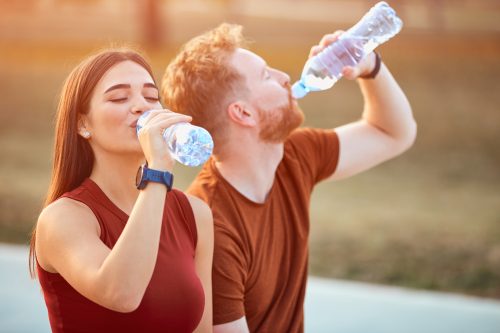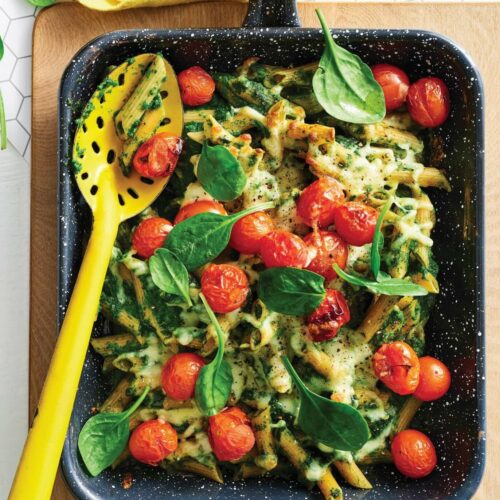
Our brains are about 70 per cent water (while our bodies are about 60 per cent), so it’s not surprising that inadequate hydration can cause a drop in performance at work and cause tiredness, loss of concentration and headaches.
Drinking enough water each day helps with essential processes in your body, from regulating your body temperature and keeping joints lubricated to delivering nutrients to cells and keeping organs functioning properly. And, being well-hydrated can help with sleep quality, cognition and mood.
Your Challenge: Track the amount of fluid you have each day and aim to drink enough so your pee is pale*
We know this is easier said than done; busy schedules can make it hard to remember to drink enough during the day and some industries/working environments can make it harder for you to access water regularly or even to be able to keep a bottle nearby. So, here are our top tips to stay hydrated:
- Start your day with a glass of water – no matter what (this can even be during your commute)
- Fill up a large water bottle or two in the morning and take it with you for the day
- To ensure you’re getting enough water, consider purchasing a bottle with a trackable gauge, so you can see how much water you’ve consumed and by what time of the day, to guarantee you’re staying hydrated. Or, for a cheaper option, use a permanent marker to mark lines on your existing water bottle
- If you’re beginning to feel the onset of any of the previously mentioned signs of dehydration, your first port of call should be to get yourself a drink of water. Regardless of the situation, you are in. If necessary, make it clear to your boss that this is essential
- Learn more about what your urine says about you. Print out this pee chart and put it on the back of your toilet door to keep you in check. The body also has its own indicators of hydration levels – keep an eye on urine colour when you are visiting the lavatory and get yourself a refill if it is any colour other than pale
- Create a new habit around times to drink water, eg, when you first wake up, when you need a break from your emails, when your phone rings or before each new task. Schedule alarms to remind you, if need be
- You can eat water too! Water-rich fruits and vegetables can play a big role in helping you meet your hydration needs as well as boosting your fibre, vitamins and antioxidants. Here are some good examples: lettuce 97 per cent water, tomatoes 94 per cent water, capsicum 92-94 per cent water, asparagus 93 per cent water, strawberries 91 per cent water, watermelon 90 per cent water.
Not too keen on the taste of water? Try these ideas:
- Check out the huge range of hot and cold brew tea bags (you can find these next to the other teas at the supermarket). They have no sugar in them and there are all sorts of flavours, from lemon and lime, to tropical, raspberry, mango and many more.
- Add sliced fruit to your water. Lemon, lime, apple, pear or a small handful of frozen berries all work well
- Slice up cucumber to give water a new level of refreshment
- Give herbs a whirl. Crushed mint, a sprig of rosemary and basil all work well.
Need help?
- Check out our easy guide when choosing kombucha
- Want hot drink options? Try these
- Does coffee dehydrate you? Find out here
- Many drinks are high in sugar meaning overconsumption can increase the waistline and diabetes risk and impact dental health. Find out how much sugar is in your favourite drink here, and more here.
How much do I need to drink?
Six glasses? Eight cups? Two or three litres? If you ask someone this question, you will probably get one of these answers, but which one is right? Well, none of them really.
Drinking a couple of litres a day is a good rough guide, but the exact amount you need to drink varies from person to person. Some people will need more than others and the amount is affected by factors such as your age, sex, how active you are, and how much time you spend inside or outside. If you do a lot of exercise, you might be surprised how much fluid you need to replace after sweating. Some people can lose up to two litres an hour during an intensive workout or sports game.
The goal is to drink enough to make sure that during the day you are passing large volumes of very pale straw-coloured pee, which might mean you need to be drinking a lot more than you are drinking now. If it’s dark, you aren’t drinking enough, so it’s time to have some water.
*Note: Some supplements and medications may alter the colour of your urine. If you are taking a multivitamin, for example, which has B vitamins in it, your pee might be much more bright yellow than normal. In this case, the pee chart may not be an accurate indicator of your hydration, so aiming for 2-3 litres a day instead would be a good goal.
Article sources and references
- Sleep Foundationhttps://www.sleepfoundation.org/nutrition/hydration-and-sleep
- Cambridge University Presshttps://www.cambridge.org/core/journals/british-journal-of-nutrition/article/mild-dehydration-impairs-cognitive-performance-and-mood-of-men/3388AB36B8DF73E844C9AD19271A75BF
- Oxford Academichttps://academic.oup.com/jn/article/142/2/382/4743487
- US National Library of Medicine, National Institute of Healthhttps://www.ncbi.nlm.nih.gov/pmc/articles/PMC4325863/
- Health Linehttps://www.healthline.com/nutrition/7-health-benefits-of-water
- Havardhttps://www.hsph.harvard.edu/news/hsph-in-the-news/the-importance-of-hydration/
- Harvard Medical Schoolhttps://www.health.harvard.edu/staying-healthy/the-importance-of-staying-hydrated
www.healthyfood.com










